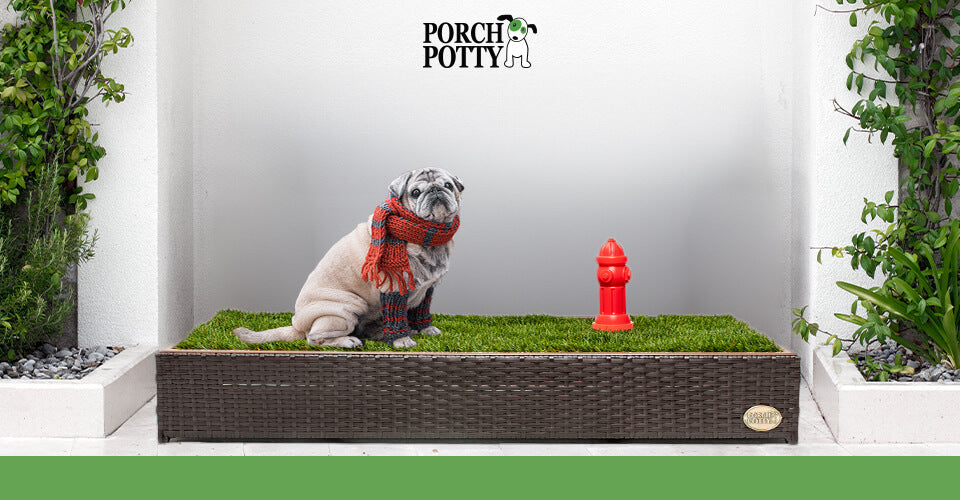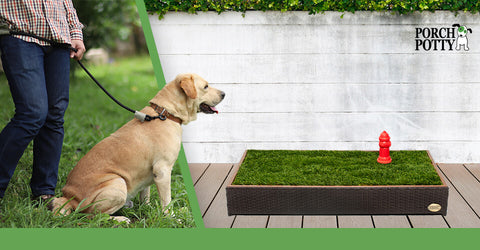
A senior dog wearing an orange scarf sits on a Porch Potty.
Regardless of the age of a dog, they remain our babies till the end of time. And all babies are entitled to some amount of TLC, especially when teaching them to adapt to something new. The Porch Potty does its bit by helping you improve the quality of your senior dog’s life and making bathroom breaks a cake walk for your dog while also cutting down the need for you to step out with your dog every now and then for those short and long potty breaks. All you need to do is invest a little time in helping your senior dog adapt.
Let’s understand the nitty gritty of how we can smooth out this transition from outdoor bathroom to indoor Porch Potty for our senior dogs.
Understanding Your Older Dog
Senior dogs have spent a lifetime learning and maneuvering their way in the household. They have spent quite the number of years in building and practicing a variety of habits and routines. Of all these behaviors and habits, re-potty training or transitioning your dog from using one spot to the other can be the trickiest because several factors play an influential role when a dog decides to consistently relieve themselves in a certain spot. Thus, a little rigidity and wanting to do things their way is natural.
As pet parents, when transitioning an older dog from outdoors to indoors, we must remember to have the following things in place –
- Endless patience
- The willingness to be super consistent
- Accommodate the senior dog’s preferences
- Adjust to their body clock
- Reward often
- Be prepared for failures and some amount of accidents
- Dealing with some amount of frustration
7 Steps to Helping an Older Dog Adapt
“Take it slow” should be the biggest mantra of training your senior dog to use the porch potty instead of stepping out frequently for bathroom breaks. A habit formed over several years will take its own sweet time to kick to the curb. Here is a step-by-step guide to help you accelerate and smoothen out the transition process.
Start carrying the grass patch of the Porch Potty to your dog’s current designated spot
If your older dog is accustomed to peeing on natural grass, the good news is they are more likely to take to the Porch Potty sooner or later. It could be a lot sooner if you start making the surface of the Porch Potty available at your dog’s current preferred surface. Carry the fake grass patch and lay it on your dog’s designated spot and see if they show any interest in it. You could spray pheromone sprays or other potty training attractant sprays to encourage your dog to pee on it.
Gradually reduce the frequency of going outdoors
Setting a new habit will be a challenge if your dog still has access and opportunity to perform their old habits. However, this doesn’t mean that we completely cut off the outdoors. Gradually reduce the frequency of going outdoors and encourage your dog to hang out around the Porch Potty whenever they feel the need to relieve themselves. Consider changing the timings of stepping outdoors. Instead of going out at their regular times, step out a few hours later or earlier.
Delay going out during crucial times like early in the morning and hang out around the Porch Potty instead
Every dog needs to relieve themselves first thing in the morning, as soon as they wake up. Holding bladder for too long can be difficult, which can encourage your senior dog to relieve themselves on the next easily available surface. Let this be the Porch Potty. Lead your dog near the Porch potty as soon as they wake up and engage in some kind of play to get their system going. With no access to their current designated spot combined with their dire need to pee, training them to use the Porch potty will be a lot easier.
However, this must be done very carefully. Several dogs may choose to hold their bladder for hours together and wait till they get outside. This may end up spoiling your senior dog’s health.

An older yellow Labrador Retriever looks at a Porch Potty while its owner holds a leash.
Proactively lead your older dog towards the Porch Potty at scheduled times
Your senior dog is not going to magically know that they need to void their bladder indoors on Porch Potty. They have to be patiently trained to do so. This means thoroughly understanding their body clock and proactively leading them towards the porch potty at the scheduled times.
Generally, dogs need to go to the bathroom immediately after they wake up, after meals, water intake, during play and last thing before bed. These timings may vary for different dogs, especially senior dogs. If need be, use a leash to lead them to the Porch Potty. However, also remember that putting the leash on may lead some dogs to believe that they are being taken outside.
Make sure the Porch Potty is easily accessible
Your senior dog is more likely to learn and perform a new behavior or habit if it is easy for them to do it. If your dog has to walk from one corner of the house to another to reach the Porch Potty or maneuver through a lot of furniture, they may just give up and choose to either wait or have an accident instead. Set up the Porch Potty in a quiet environment and make sure it is very easily accessible to your senior dog at all times.
Allow your dog to replicate their pre- and post-potty behaviors around the porch potty
Every dog engages in pre- and post-potty behaviors like circling, sniffing excessively, moving around, playing etc. Observe what behaviors your senior dog engages in currently at their existing designated area and allow them to carry out similar behaviors around the Porch Potty. Make sure there is enough space for them to move or play around if need be.
Discourage your dog from resting and napping around the porch potty
Dogs instinctively avoid soiling the spot on which they rest and eat. The Porch Potty definitely has an inviting surface and may encourage several dogs to lay down and chill. However, make sure to discourage your dog from doing so. Once your senior dog starts associating the porch potty as a place to rest or nap, it will be challenging to train them to pee on it.

A Wolfhound's owner offers a treat as a reward for good behavior.
Positive Reinforcement and Consistency
Positive reinforcement works for every dog at every age
Positive reinforcement involves rewarding a behavior to increase the likelihood of that behavior being repeated in the future. This is one of the most absolute ways of training a dog and has less room for failure. Every dog, including senior dogs, thrive on appreciation, love and rewards. Hence, teaching an older dog a new trick will be a lot easier if we just reward them for the right behavior at the right time consistently.
Rewarding small wins are stepping stones to achieving big wins
Shaping is a training technique in which a behavior is gradually developed by reinforcing small steps or approximations toward the final behavior. Although using the Porch Potty to pee may seem quite straight forward, you can still use shaping technique in this case. Reward small steps like your dog looking at the Porch Potty, showing interest in it, sniffing it, climbing it and then finally peeing on it.
Dogs are creatures of habit, hence consistency is a game changer
At any age, dogs learn through repetition. When transitioning your senior dog from going outdoors to peeing indoors on the Porch potty, make sure to show unwavering consistency in routine setting, positive reinforcement as well as leading your dog up to the Porch Potty. Your dog may show resistance at first, but with patience and consistency, they will certainly take to the Porch Potty.
Troubleshooting
“My senior dog holds his pee till we get outside, no matter how hard I try to get him to pee on the Porch Potty.”
Expect resistance when trying to break a habit that has been formed over a span of several years. Gradual progression is imperative in the transition process. Tactfully delay the time of stepping outdoors in the morning and reduce the frequency of going outside during the day. Try keeping the Porch Potty near the door. You could also rub a pee pad on your dog’s pee and place it on the turf. This familiar scent may attract your dog to pee on the Porch Potty. Make sure to reward your dog every time they show even the slightest interest in the Porch Potty. If your senior dog still prefers to hold his bladder, try meeting your dog midway and take him outside at least once a day.
“My senior dog pees on the Porch Potty but does not poop on it.”
It is common for dogs to not want to pee and poop on the same surface. This is rooted in their natural instincts. Apart from reasons such as territorial marking and communicating with other dogs, they avoid contamination in the same spot and tend to prefer two completely different areas to pee and poop. To tackle this behavior, you could set up two turfs in the house in different areas of the house and lead your dog to those areas individually. If that is not an option, place a pee pad next to the Porch potty and see if your dog shows any interest to poop on it. If nothing works, consider stepping out with your dog just for pooping.
“My older dog naps on the Porch potty.”
This generally happens when the dog is given way too much access around the porch potty. It is important that the porch potty must be easily accessible when the dog needs to pee or poop, but cut off access once they are done with their business. This is imperative so that your senior dog does not start napping and relaxing on it. Encourage your dog to be physically active around the porch potty so that they can quickly relieve themselves. Once done, proactively take them away from the spot. If your dog has already developed the habit of napping on it, use potty training sprays as attractants on the turf.
Transitioning a senior dog to use a Porch Potty indoors rather than going outside can vary significantly from one pet to another, reflecting their unique preferences and natural instincts. While some may adapt quickly to this change, others might find it challenging, underscoring the importance of consulting with a veterinarian and a behaviorist to ensure the transition is suitable for your dog's specific needs.
Siddhika Bhat, Certified dog trainer and behaviorist and founder of Wag A Bond.
For more information on training your senior dog, check out these articles:
How to Potty Train an Older Dog
How Can I Support My Aging Dog?
How to Potty Train an Older Dog and Keep Your Carpets Odor Free





1 comment
I need this in Fl mainly in summer months in case of hurricane